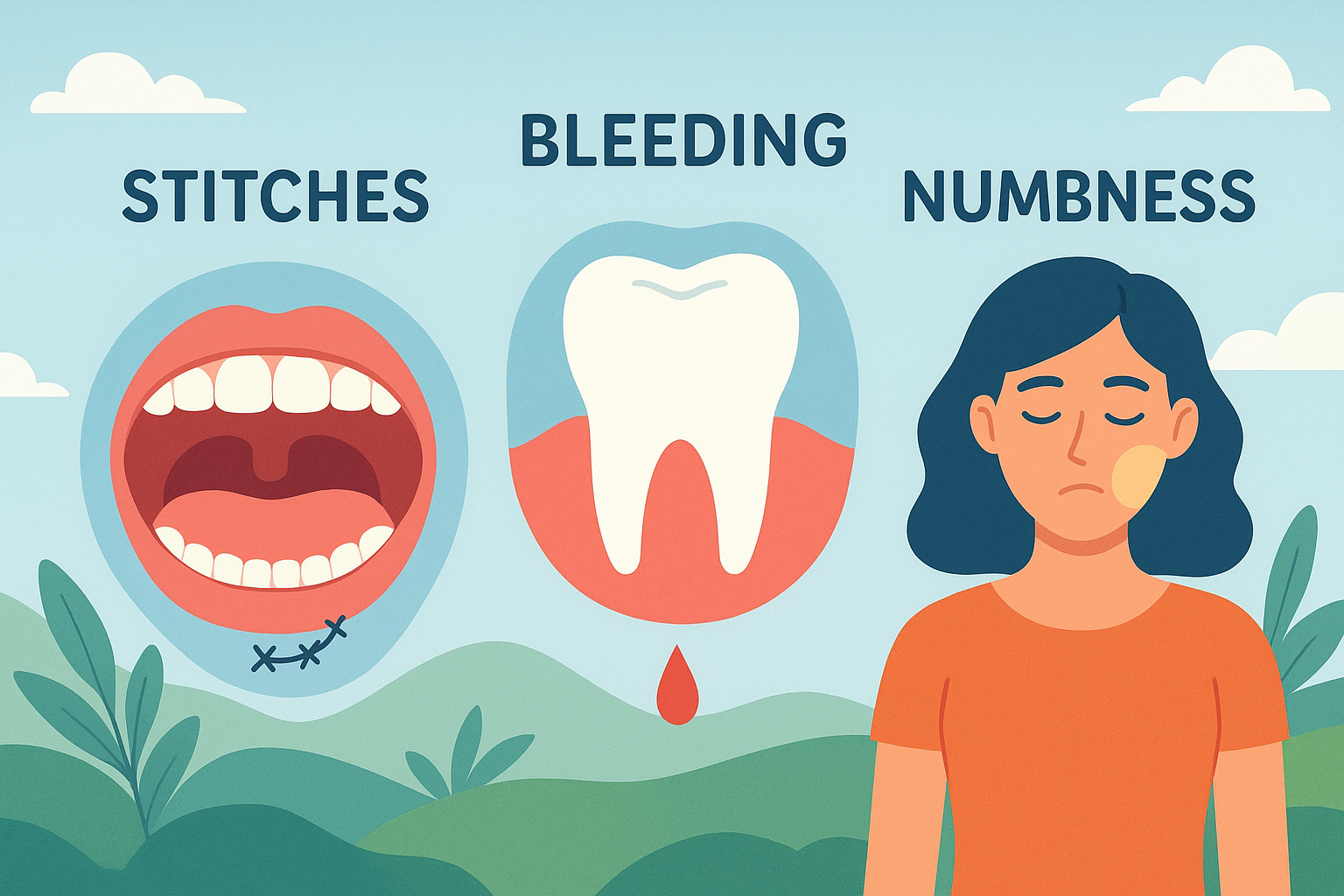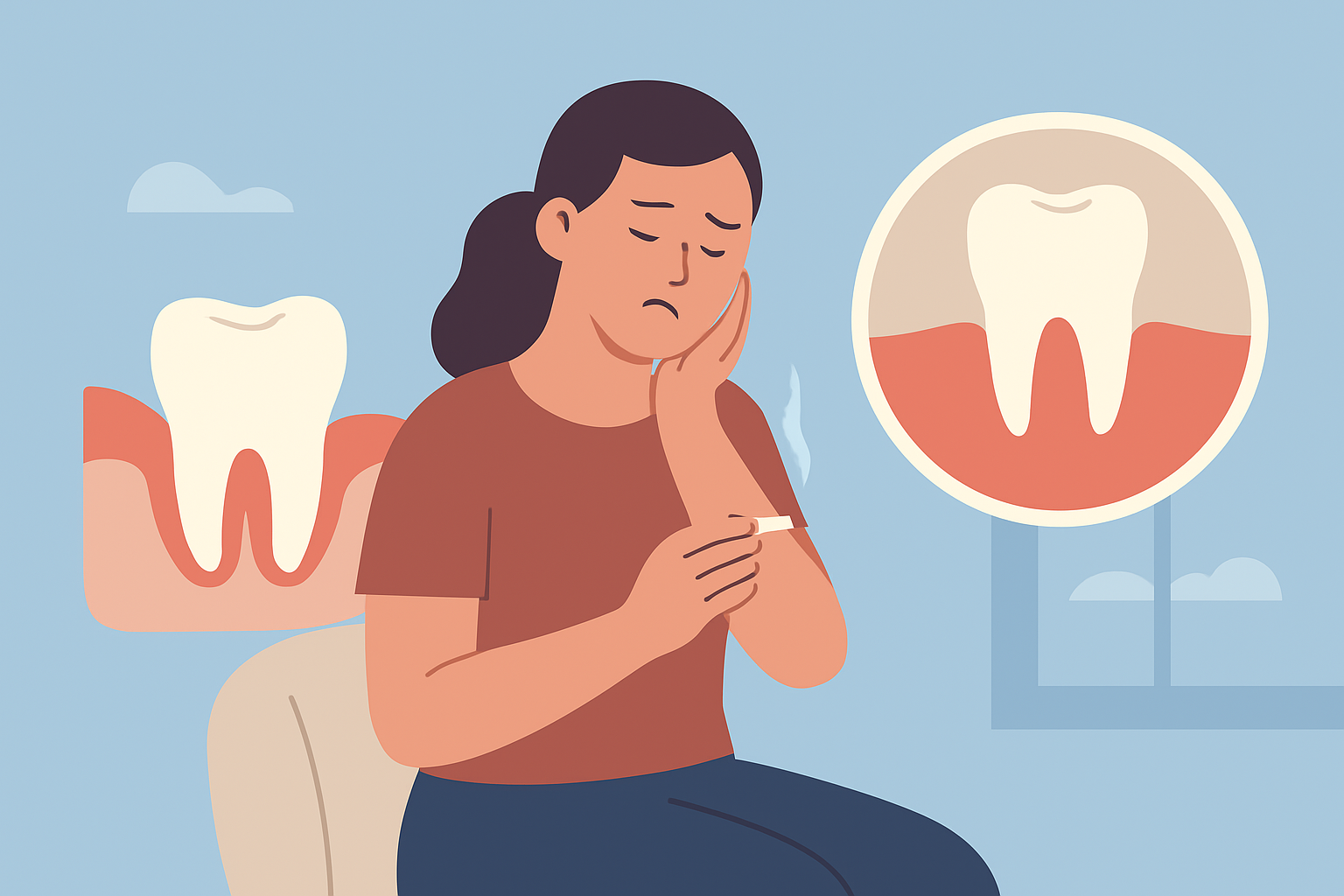Stitches, Bleeding, Numbness: Your Wisdom Tooth Healing Guide

Recovering from wisdom tooth extraction can feel confusing, especially when you’re unsure whether your symptoms are completely normal or a sign that something’s wrong. Stitches, mild bleeding, and temporary numbness are all common parts of the healing process, but knowing what to expect—and when to be concerned—can make recovery far less stressful.
This guide breaks down everything you need to know about what’s normal after wisdom tooth removal, how long symptoms typically last, and the red flags that mean you should reach out to your oral surgeon. With clear explanations and a helpful recovery timeline, this long-form guide helps you feel prepared, calm, and informed throughout healing.
Understanding What Happens During Wisdom Tooth Removal
Before assessing what’s normal after the procedure, it helps to understand what actually happens during extraction. When a wisdom tooth is removed—especially if it’s impacted—the dentist or oral surgeon creates an incision in the gums and may remove a small amount of bone to access the tooth. This is one of the key differences explained in discussions comparing simple vs. surgical extractions.
In many cases, sutures are placed to help the gum tissue heal and reduce bleeding. The nature of your extraction—whether simple or surgical—also affects how much swelling, bleeding, or numbness you may experience afterward.
Some patients also want to understand what led to extraction in the first place, especially if there were signs of misalignment. If that applies to you, it may help to learn more about how to know if your wisdom tooth is growing wrong.
What’s Normal After Wisdom Tooth Removal?
Normal Symptom 1: Mild Bleeding or Oozing
Light bleeding or pink-tinged saliva is very common in the first 24 hours. The body is forming a blood clot at the extraction site, and minor oozing is expected.
What’s normal:
- Slight bleeding that reduces through the day
- Pink saliva when drinking water
- Occasional spotting when you rinse or spit
- Bleeding that improves when applying light pressure with gauze
What’s not normal:
- Bleeding that soaks gauze repeatedly
- Bright red bleeding that doesn’t slow down
- Bleeding that starts again heavily days later
Soft pressure, staying upright, and avoiding irritation usually help. However, heavy or persistent bleeding should be evaluated by your oral surgeon.
Normal Symptom 2: Swelling and Tenderness
Swelling is one of the most noticeable parts of recovery. It generally peaks within the first 48–72 hours and then slowly decreases. However, factors such as climate and activity can influence how much swelling you experience. For example, those in warmer environments may relate to the insights shared about swelling after wisdom tooth removal in Florida heat.
What’s normal:
- Puffiness around the cheeks and jaw
- Stiffness when opening your mouth
- Mild bruising that appears a few days later
- Swelling that peaks by day 3 and improves afterward
What’s not normal:
- Swelling that continues growing after day 4
- Fever alongside swelling
- Any sign of pus or foul odor
Swelling alone is usually not a concern—what matters is the pattern. Improvement after the third day indicates normal healing.
Normal Symptom 3: Pain and Soreness
Pain after extraction is expected, but it follows a predictable path.
What’s normal:
- Aching or throbbing the first 1–3 days
- Peak discomfort around day 2
- Gradual improvement day by day
- Relief when using prescribed or recommended pain medication
What’s not normal:
- Sharp, worsening pain after day 3
- Pain spreading to the temple or ear
- Foul odor or an empty-looking socket (possible dry socket)
Pain that increases instead of decreasing should always be checked, especially if accompanied by an unpleasant taste, odor, or exposed bone.
Normal Symptom 4: Stitches in the Surgical Area
If stitches were placed, they help keep the gums closed as the area heals.
What’s normal:
- Stitches feeling a bit tight
- Mild pulling sensations when eating
- Dissolvable stitches loosening after several days
- Stitches falling out on their own within 7–10 days
What’s not normal:
- Stitches falling out immediately after surgery
- Bleeding that starts when stitches loosen
- A wide-open surgical site
Most stitches dissolve without any intervention, but always notify your oral surgeon if you think the site has reopened.
Normal Symptom 5: Temporary Numbness
Numbness is another symptom that can make patients uneasy. It occurs when the nerves near the extraction site have been irritated.
What’s normal:
- Numbness in the tongue, chin, or lips
- Tingling as sensation returns
- Numbness lasting a few hours or even a couple of days
What’s not normal:
- Numbness that lasts more than 48–72 hours with no improvement
- Electric shock sensations
- Complete loss of sensation on one side
Temporary numbness almost always resolves, but persistent numbness should be evaluated—especially after lower wisdom tooth removal.
What’s Normal at Each Stage of Healing?
Day 1: The Clotting Stage
Expect mild bleeding, discomfort, swelling, and numbness. Rest is essential.
Days 2–3: The Peak Inflammation Stage
This is when swelling and discomfort crest. Using cold compresses and keeping activity low helps significantly.
Days 4–7: The Repair Stage
Stitches begin dissolving, swelling improves, and chewing becomes easier. For more guidance on managing this stage, you may find value in these practical recovery tips after wisdom teeth removal.
Week 2: Tissue Strengthening
Gums continue closing over the extraction areas, and sensitivity lessens.
Weeks 3–4: Continued Healing
Most discomfort has faded, though mild tenderness near the site is possible.
Warning Signs You Should Not Ignore
Reach out to your doctor if you experience:
- Intense or worsening pain after day 3
- Continuous heavy bleeding
- Fever or chills
- Severe swelling that grows instead of shrinking
- Pus, foul odor, or unpleasant taste
- Difficulty swallowing or breathing
- Numbness that doesn’t improve
These symptoms may indicate infection, dry socket, or nerve-related complications.
How to Support Faster, Safer Healing
Follow Post-Op Instructions Closely
Your surgeon’s guidance reflects the specifics of your extraction.
Protect the Blood Clot
Avoid straws, spitting, or anything that creates suction. If you smoke, be aware that research consistently shows how significantly it slows healing, as highlighted in insights about how smoking affects wisdom tooth healing.
Use Cold Compresses Early
Ice during the first 24 hours reduces swelling and inflammation.
Maintain Gentle Oral Hygiene
Brush carefully around the extraction area and begin warm saltwater rinses after 24–48 hours if recommended.
Choose Soft Foods and Safe Drinks
Stick with soups, yogurt, mashed foods, and smoothies (without straws). Hydration matters, and it helps to know exactly which drinks are safe after wisdom tooth removal.
Rest Well
Healing accelerates when you avoid strenuous activity and get quality sleep.
When Do Most People Feel Normal Again?
Every patient heals at their own pace, but here’s the general timeline:
- Day 4: Major discomfort improves
- 1 week: Most daily activities feel manageable
- 2 weeks: Gum tissue closes significantly
- Several weeks: Complete gum healing
- Several months: Deep bone healing
Even if you feel better early, remember the tissues inside the gum continue healing long after the discomfort fades.
If your extraction came from a preventive approach, you may be interested in learning more about why wisdom teeth don’t always need removal.
Final Thoughts: Understanding What’s Normal Helps You Heal Confidently
Stitches, minor bleeding, swelling, and temporary numbness are all part of the standard healing process after wisdom tooth removal. Knowing what’s normal—and what isn’t—helps you stay calm, make informed decisions, and reach out for help when necessary.
With proper aftercare and awareness, you can move through recovery smoothly and return to normal life much faster.

How to Avoid Dental Problems After a Tooth Extraction
December 17, 2025

How Smoking Affects Wisdom Tooth Healing
November 13, 2025

Wisdom Teeth Removal Recovery Tips: How to Heal Faster and Avoid Problems
November 10, 2025

Why a Dentist Might Delay an Extraction?
December 8, 2025

Long-Term Results After Jaw Surgery: What to Expect
December 1, 2025